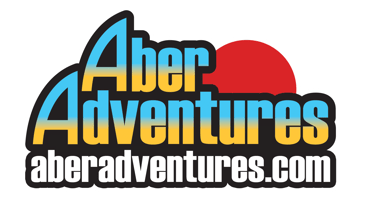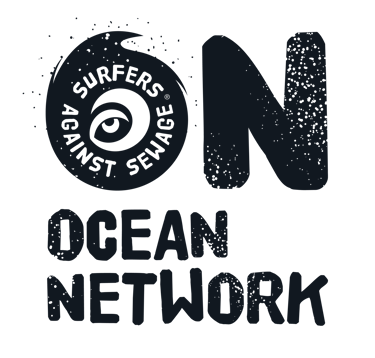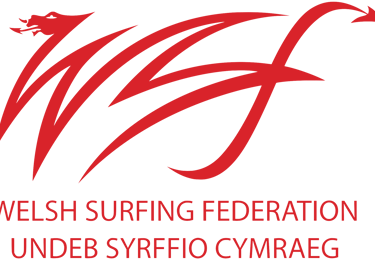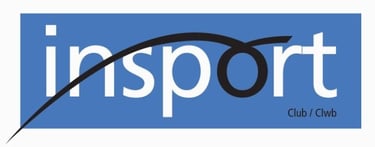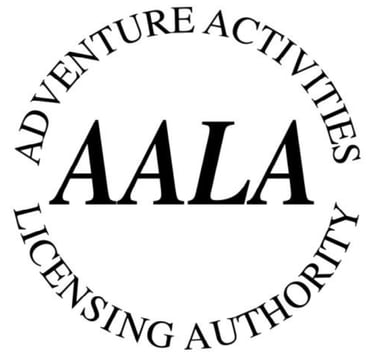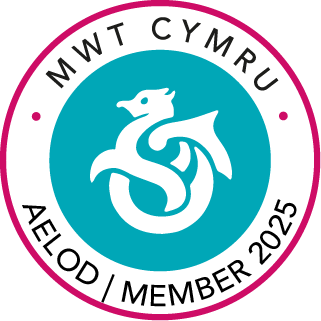
SURFING TERMINOLOGY
Surfers do often sound like they are talking a foreign language. Here is guide to decipher the jargon.
SURFING ADVICE
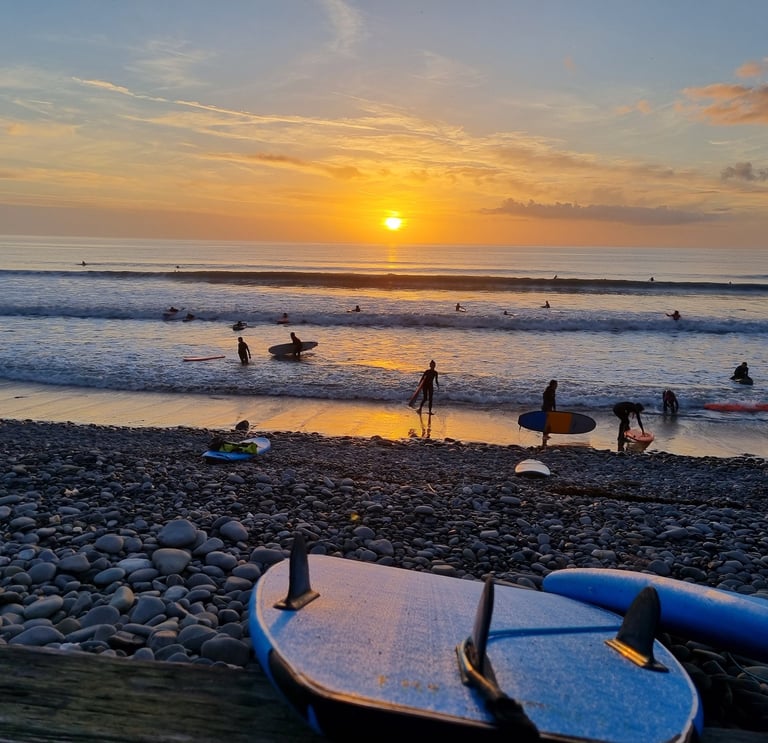

To a non surfer listening to surfers talking about surfing, it can sound like a foreign language.
This glossary of the common (and not so common) terms, and phrases may help you decipher the jargon.
THE GLOSSARY OF SURF LANGUAGE

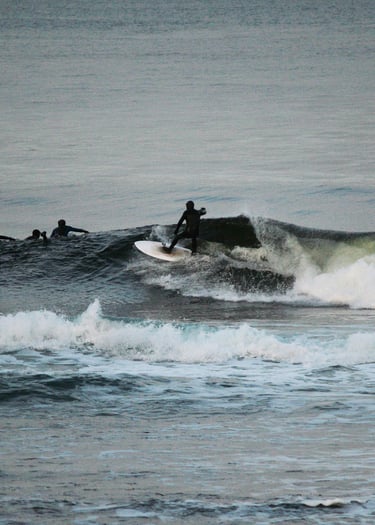
Ariel or air. A high performance move involving hitting the top of the wave and flying above it.
A-Frame. A wave that forms a peak and peels off in both directions.
Aggro. A term signifying aggression in any context.
Alaia. A traditional surfboard made of solid wood, used by the early surfers in Hawaii.
Aloha. A greeting or saying goodbye in Hawaiian, but also means love and fellowship.
Amped. Excited, fired up.
Ankle slappers. Tiny waves that are too small to surf.
Backdoor. When a surfer pulls into a hollow section of wave from behind.
Backside. A surfer riding with their back to the wave.
Bail. Ditching a surfboard, or purposely jumping off when riding a wave.
Barney. Untalented surfer or one who disrespects surfing etiquette.
Barrel. The most sought after thing in surfing. Entering inside a hollow section of a wave.
Beach Break. A surf spot that breaks at a beach over sand.
Bellyboard. A small wooden board used to ride waves prone (lying down).
Blank. A rough slab of foam, that is the core of a surfboard, before it is shaped.
Bodyboard. A small board, ridden prone or on one knee, with specific flippers.
Body surf. To catch and ride waves with just the body and maybe swim fins.
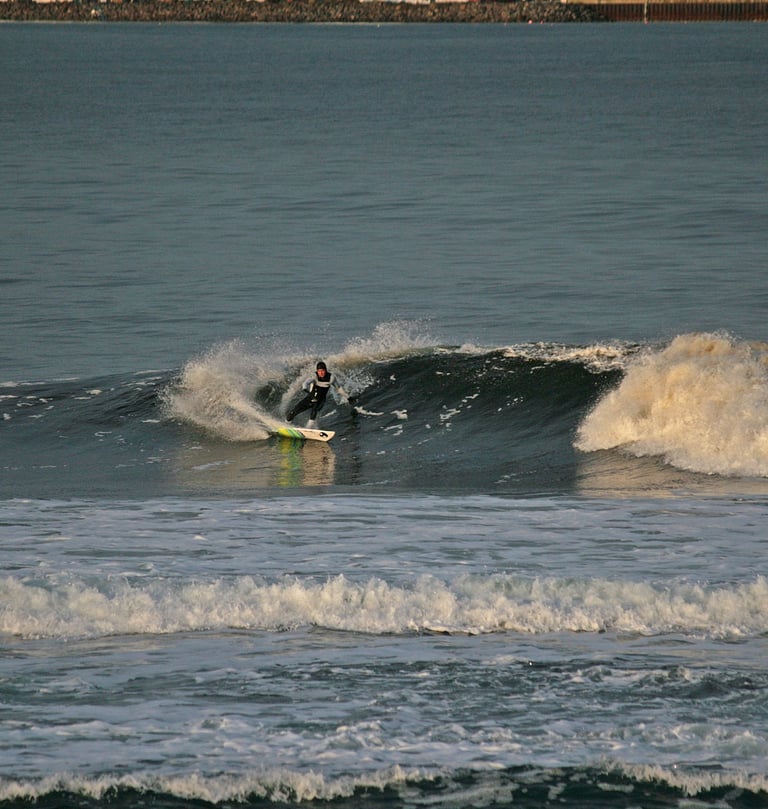

Bogging. When a surfer is too far on the board, sinking the tail and slowing or stopping the board.
Bomb. A big wave.
Bombora or bombie. A deep water off shore reef break.
Bottom turn. A set up up turn at the bottom of a wave. Arguably the most important turn to do well.
Break. When swell hits shallower water and breaks turning into waves and white water. A break is a place to surf.
Burn. To purposfully steal another surfers wave, either by dropping in or snaking.
Carve. To perform a turn on a wave face, often a sharp turn.
Caught inside. Being stuck in the inside, between the shorline and the breaking waters.
Chandelier. Water falling from the roof of a hollow wave, threatening to knock off a surfer in the barrel.
Choppy. The texture on the surface of the water, caused by excessive wind, making lots of smaller waves.
Clean. The surface of the water and the waves is smooth, caused by no wind or a gentle offshore wind.
Corduroy. Lines of big swell marchig towards the shore, giving the ocean a 'corduroy' appearance
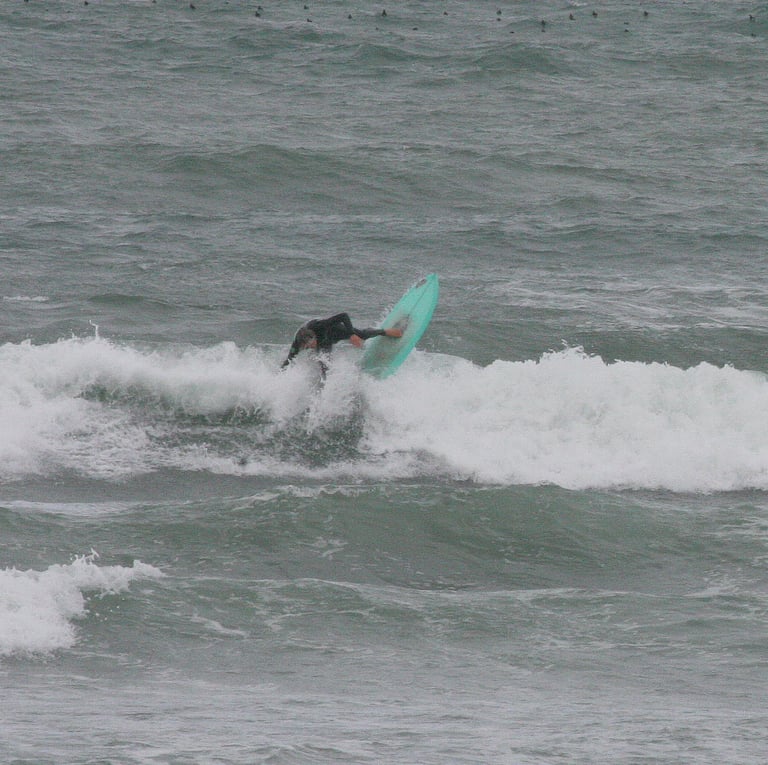

Crest. Highest part of a wave.
Cutback. A turn designed to to take a surfer back into the most powerful part of the wave (the pocket), when a wave slows down.
Dawn Patrol. A surf session just as it's getting light enough to see.
Deck. Top pf a surfboard.
Ding. Damage to a surfboard.
Drop in. Taking a wave that someone else is already riding, with priority. To drop in is also to take off on a wave and drop down the face.
Duck Dive. Pushing a surfboard underwater to avoid a breaking wave.
Fetch. The distance over which a wind blows, without a change in strength or direction.
Fin. The pointy thing on the bottom of a surfboard. Very important for direction, turning and speed.
Flat. No surf.
Floater. A maneouvre when a surfer rides over the top of a crumbling section of wave.
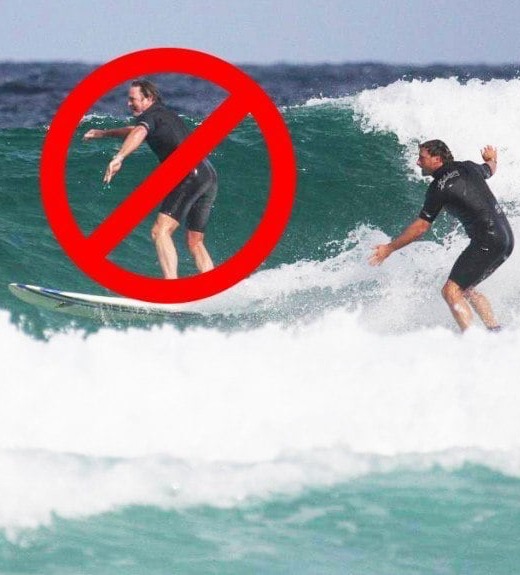

Foam. Whitewater.
Foamie. A soft surfboard, made from foam and designed for beginners. Generally, long, wide, stable and buoyant.
Frontside. Riding a wave facing it.
Froth. Amped, excited.
Glassy. When the sea surface and waves are smooth with no ripples. Caused by no wind.
Gnarly. Dangerous, scarey.
Goofy foot. A surfer how surfs with their right foot forward.
Grommet or grom. A young surfer.
Groundswell. A swell that has travelled from a storm far out to sea, powerful and with a long wave period.
Gun. A surfboard shape designed for surfing big waves.
Hang loose. A relaxed, laid back, carefree attitude.
Hang five. Hanging five toes over the end of a longboard nose when surfing.
Hang Ten. As above but all ten toes.
Hanging eleven. A naked male surfer.
Haole. Hawaiian word for clueless foreigner.
Heavy. Generally big waves that have a degree of danger. Also very powerful waves.

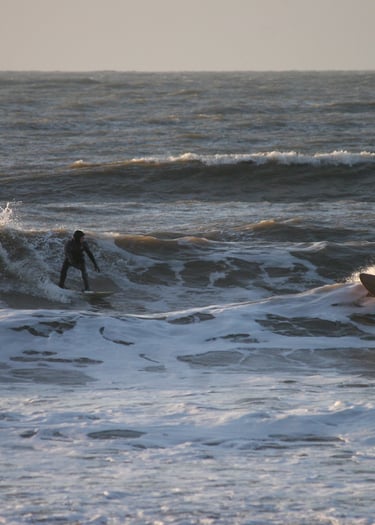
Hit the lip. Turning up the wave to hit the lipping part of a breaking wave.
Hollow. A powerful wave that breaks forming a tube or barrel.
Impact zone. Where waves first break, usually with force.
Inside. The place between the shore and the impact zone.
Jacking. When a wave suddenly rears up and breaks, going from deep to sudden shallow water.
Juice. The power of a wave.
Keg. A barrel/tube section of a hollow wave.
Kick out. Finishing a wave by turning off it out to sea.
Kook. A clueless surfer of any ability.
Layback. A maneouvre that invloves lying back on a wave after a hard turn.
Leash. The cord taht attaches a surfer to their board.
Left. A wave that breaks left when looking towards the shore.
Line up. Where surfers 'line up' to catch a wave, just past the impact zone.
Lip. The top of the wave as it's breaking.
Localism. Territorial preotection of a spot by local surfers, ofetn aggressively.

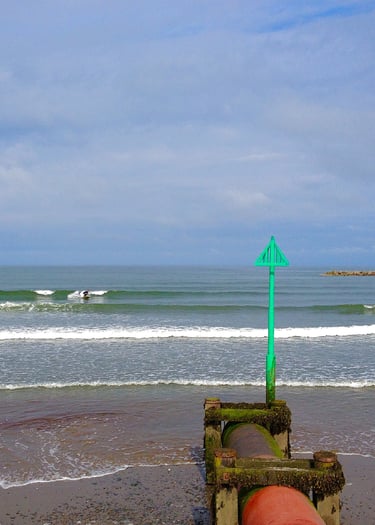
Longboard. The longest surfboard.
Lull. A gap inbetween sets of waves.
Macking. Amazing surf.
Maxed out. When waves reach there maximum size before becoming unsurfable at a spot.
Messy. Irregular and unpredictable waves, usually caused by onshore windy conditions.
Mushburgers. Weak waves with no power and difficult to surf.
Noodle arms. Tired arms from too much paddling.
Nose. The front of the surfboard.
Nose riding. Riding on the front of a longboard.
Outback/outside. The area past the breaking waves.
Over the falls. When a surfer is dragged over with the lip of the wave after wiping out.
Overhead. When the waves are higher than an average surfer.
Party wave. When more than one surfer rides the same wave.
Peak. The highest part of a wave that then breaks in both directions.
Pearling. Being too far forward on a surfboard and digging the nose into the water and nosediving.
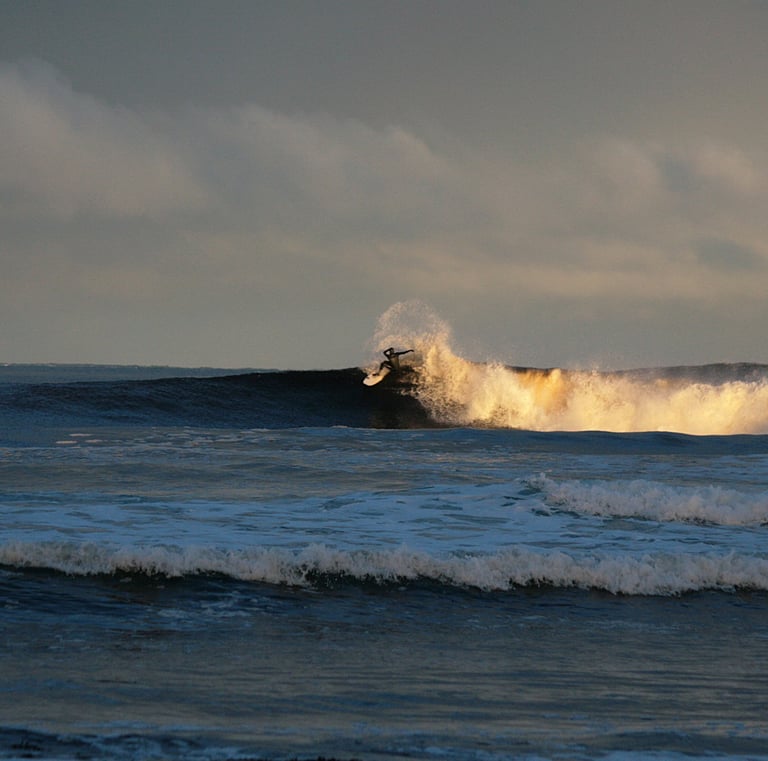

Peeling. When a wave breaks and peels in a direction.
Pit. The hollowest part of a barrelling wave.
Pitted. Tubed, barrelled. To ride inside the hollowest art of the wave.
Pocket. The most powerful, steepest part of the wave where a surfer aims to stay. Just in front of the whitewater.
Pointbreak. A wave that peels along a section of land like a headland.
Pop up. The act of going from lying down to standing with a fast pop up motion.
Pulling in. Turning or slowing a surfboard to get into the barrel.
Pumping. Really good surf or the act of generating speed along a wave.
Punt. Performing an ariel maneouvre.
Quiver. A collection of surfboards owned by a surfer.
Racy. A fast breaking surfable wave.
Rail. The sides of a surfboard.
Rash vest. A lycra under wetsuit garment to prevent wetsuit rub.
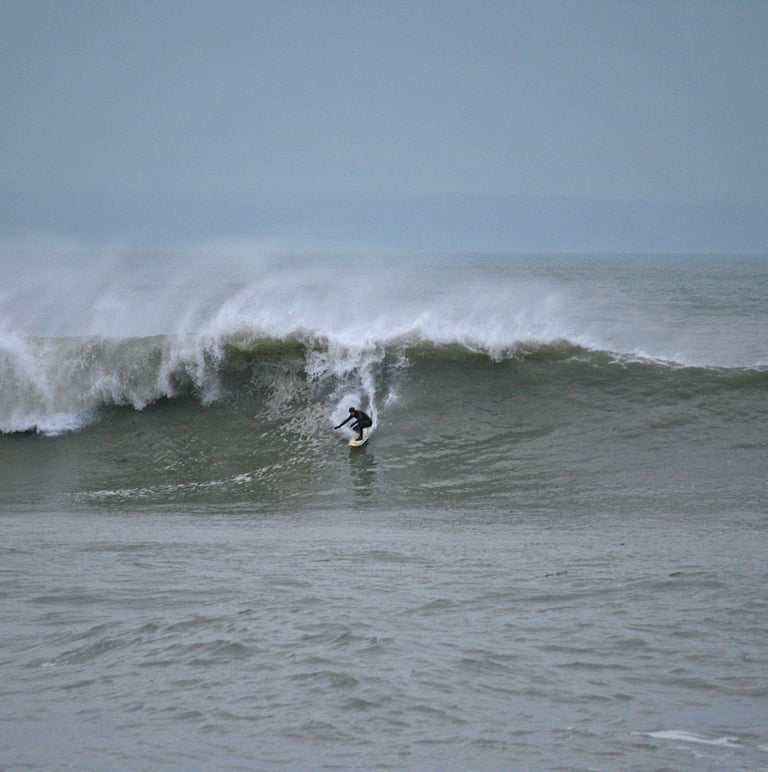

Reef break. A surf spot that breaks over rocks or coral.
Re-entry/reo. When a surfer goes vertically up and oftern over the lip and then re-enters the wave.
Regular foot. A surfer that stnads with their left for forward.
Right. A wave that breaks to a surfers right, when surfing.
Right of way. Priority is given to the surfer closest to the breaking part of the wave or peak.
Rip. To surf really well.
Rip current. A strong current of water returning water back out to sea after the waves have brought it close to shore.
Rocker. The curve of a surfboard.
Set. A group of bigger waves.
Shacked. To get barrelled or tubed.
Shaka. A surfer greeting, extending thumb and little finger.
Shaper. A surfboard designer and maker.
Shore break. Waves breaking right onto the shore.
Shoulder. The unbroken part of a breaking wave.
Sick. Amazing, awesome.
Sketchy. Tricky, dangerous.
Slab. A heavy reef break. Waves come out of deep water to very shallow water suddenly and break with huge amounts of force.
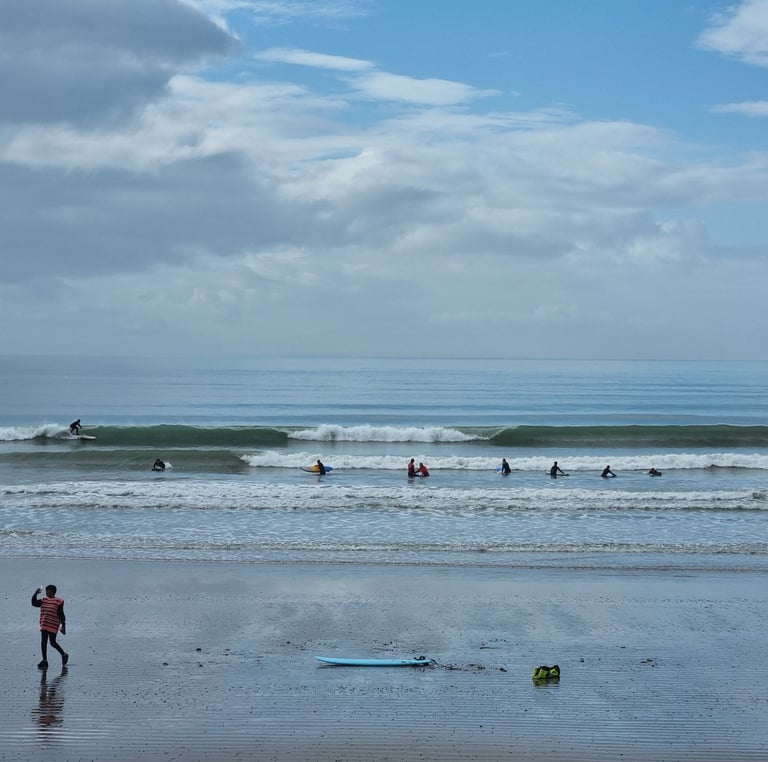

Slotted. Well positioned inside the barrel.
Snaking. Aggresively paddling around, under or over another surfer to get priority.
Soup. White water waves.
Spit. Water that is sprayed out from a barrelling wave.
Spat out. To exit a barrel with the spit.
Stall. Slowing down a surfboard.
Stick. A surfboard.
Stoked. Excited, exhilerated extremely happy.
Tail. The back of a surfboard.
Take off. The start of riding a wave.
Thurster. A three finned surfboard, the most popular set up.
Tombstoning. After a heavy wipeout and a surfer is deep under water. Just the nose of the surfers board is visible as a tombstone.
Tow in. When surfers use jet ski's to tow them into very big waves.
Trimming. Riding the unbroken part of the wave.
Tube. The inside of a powerful hollow wave.
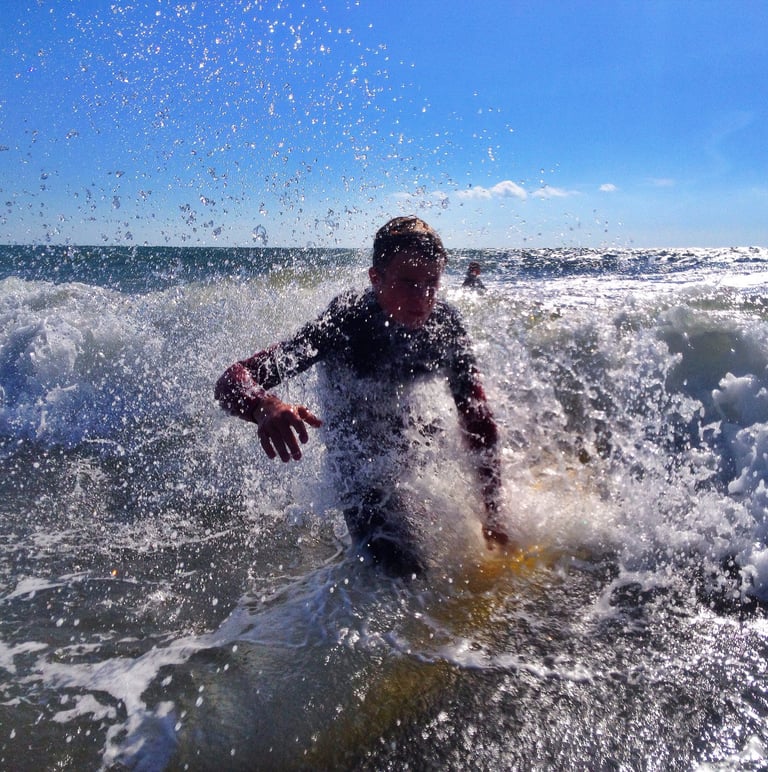

Turtle roll. Used by surfers with boards too big to duck dive under a wave. They turn the board upside down and hang underneath it to get through large waves.
Twin fin/twinnie. A surfboard with 2 fins.
Wall. A steep part of the unbroken wave.
Washing machine. Getting rolled around underwater by a broken wave.
Wave hog. A selfish surfer who doesn't share waves, snakes and even drops in.
Wax. Wax rubbed onto a surfboard deck to provide traction.
Whitewater. Foamy waves that roll to the shore after a wave has broken.
Windswell. Messy waves genrated by local winds, that tend to not have much power.
Wipeout. Falling off a wave.
Worked. Getting knocked off by a wave and then washing machined.
